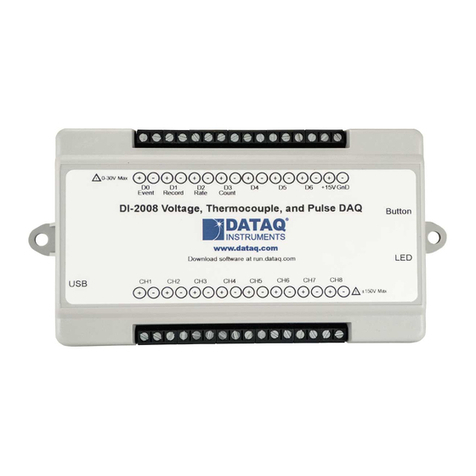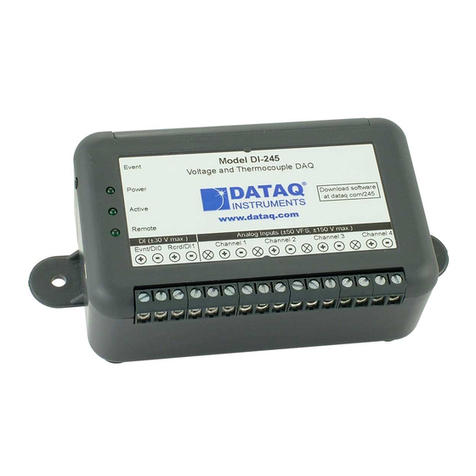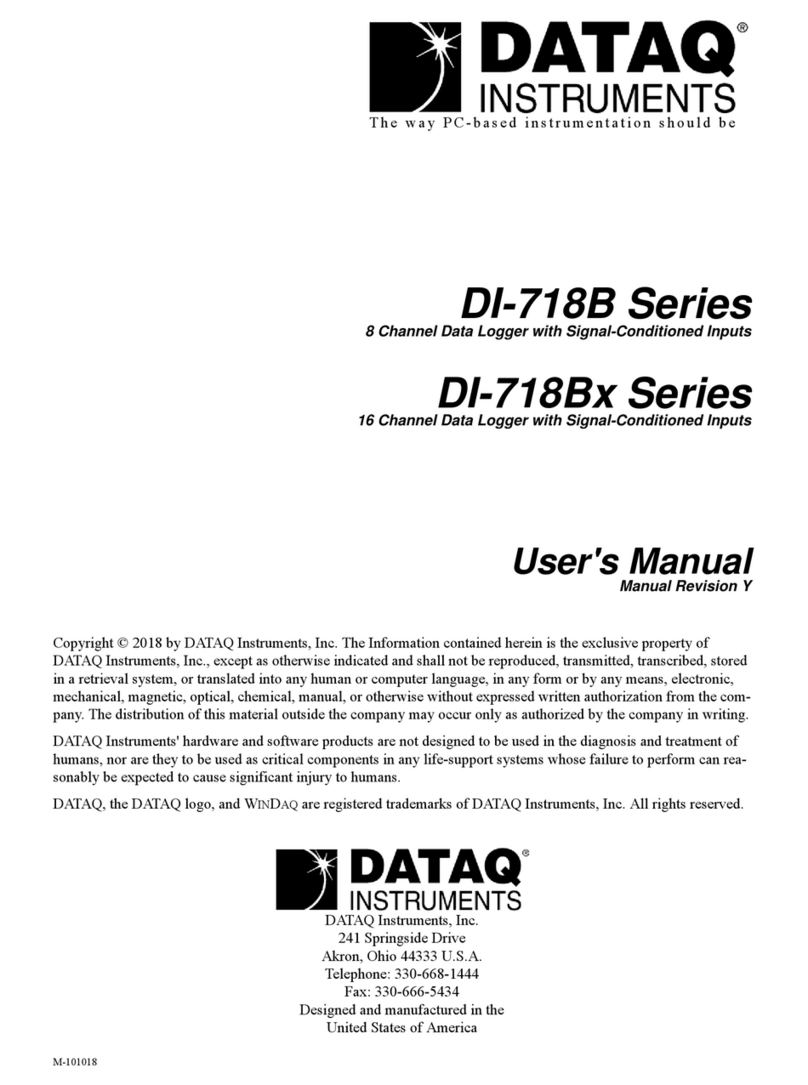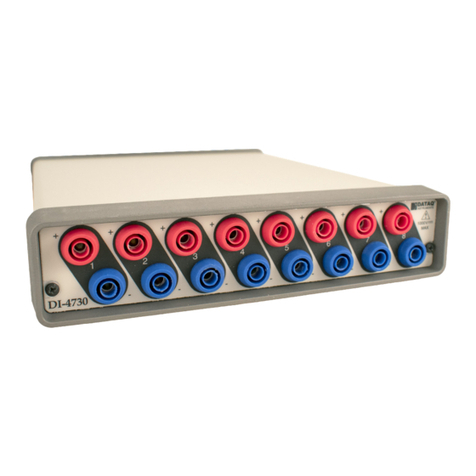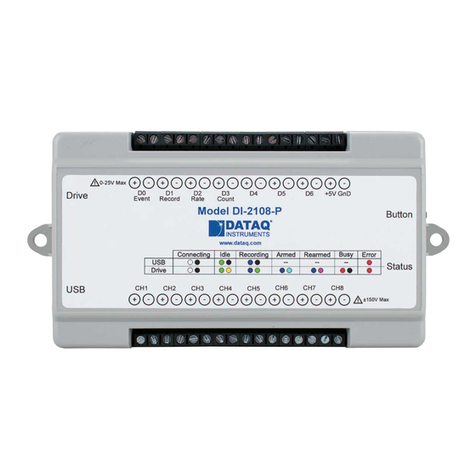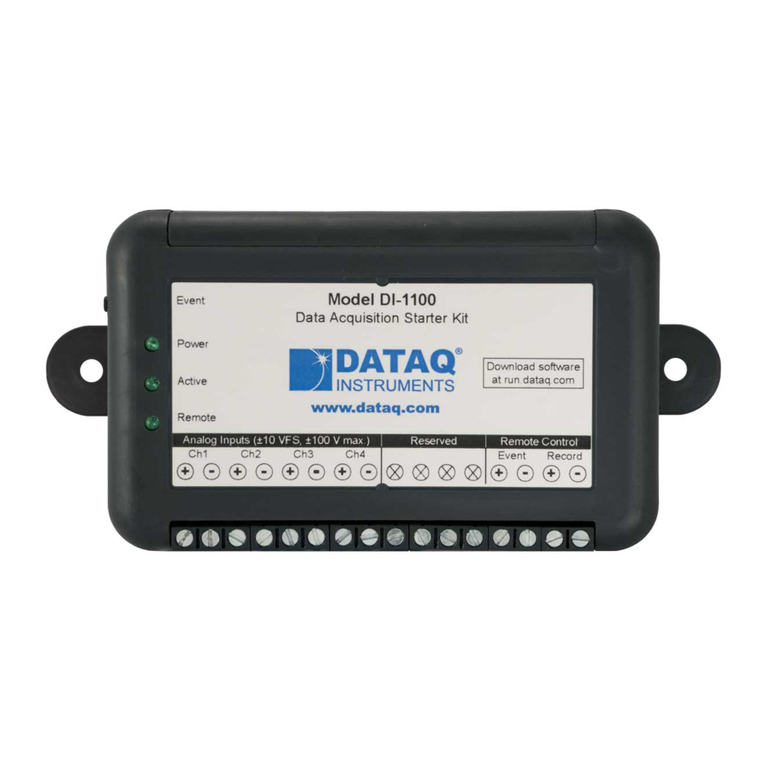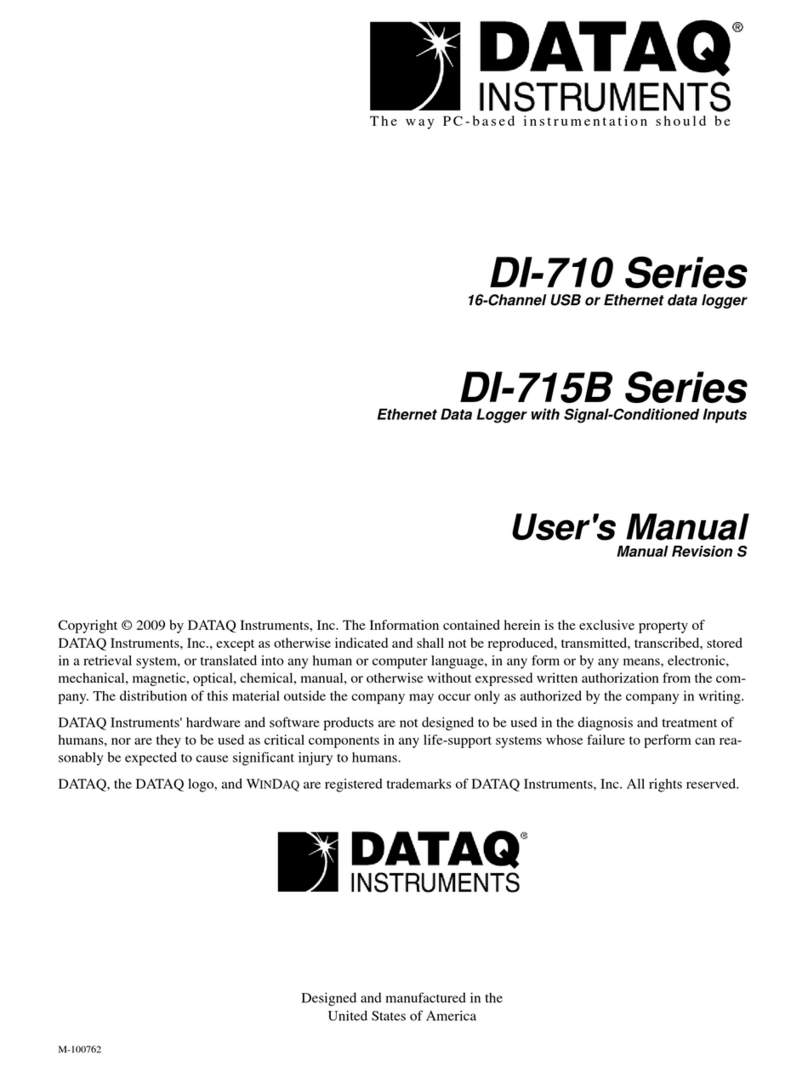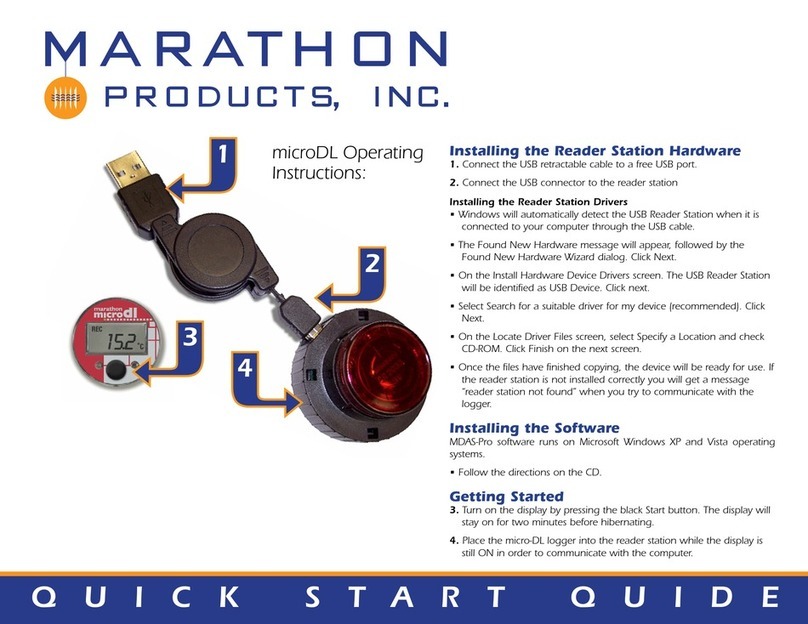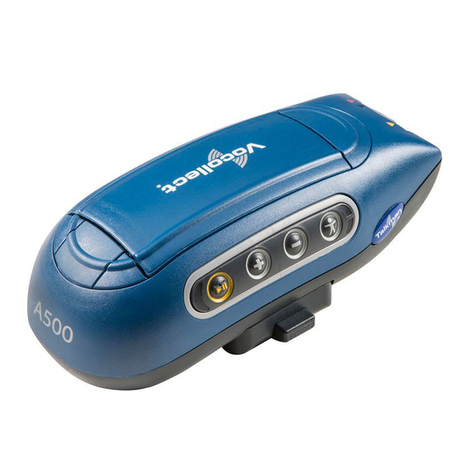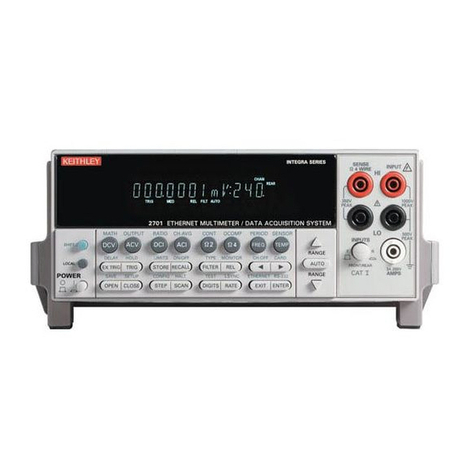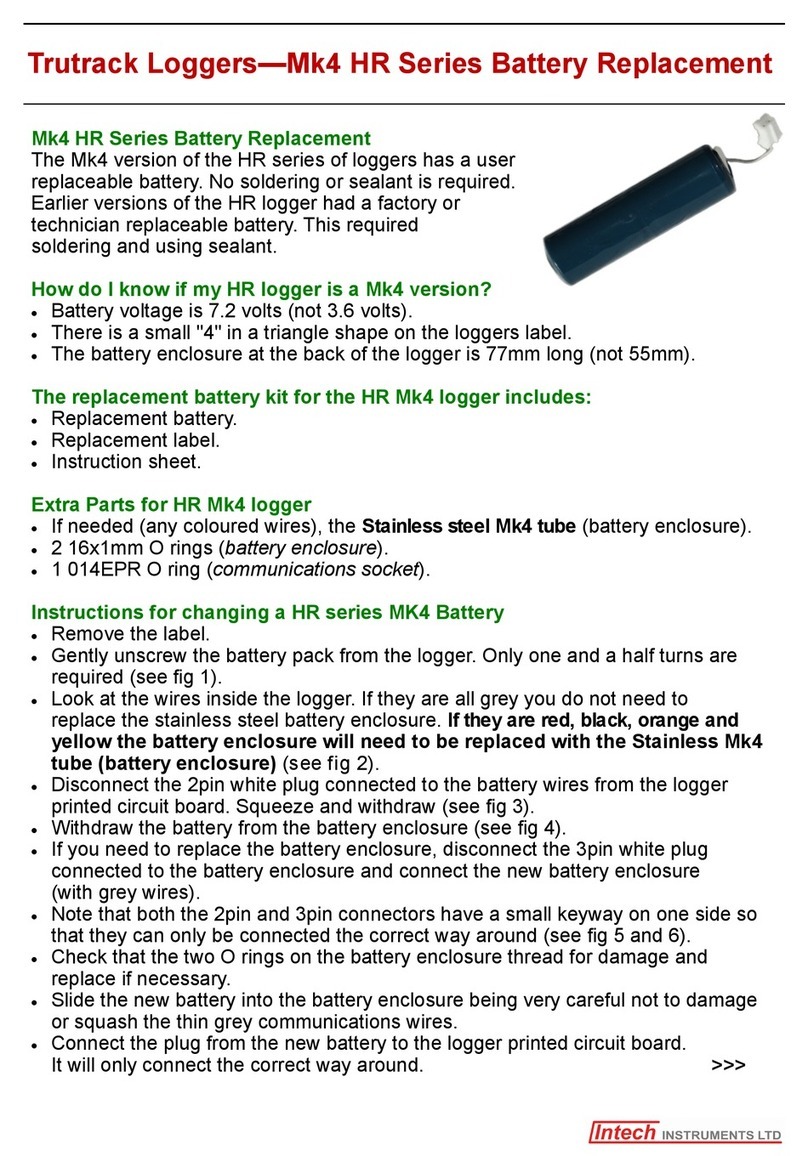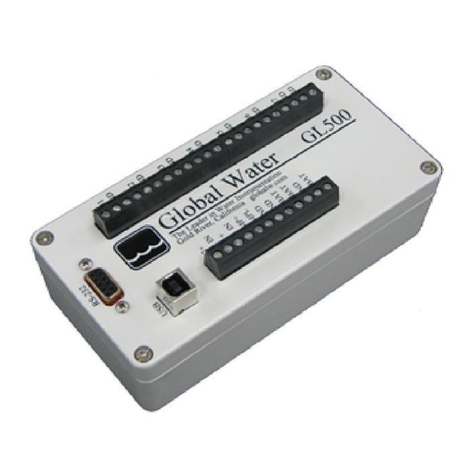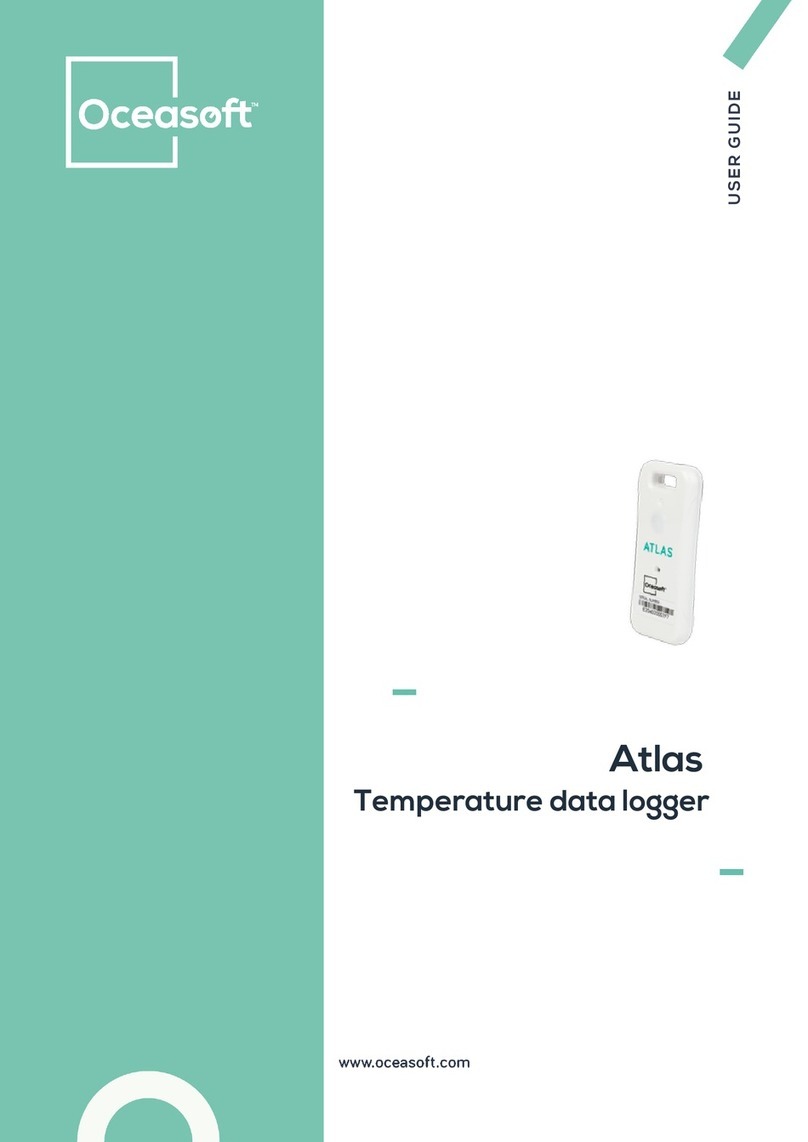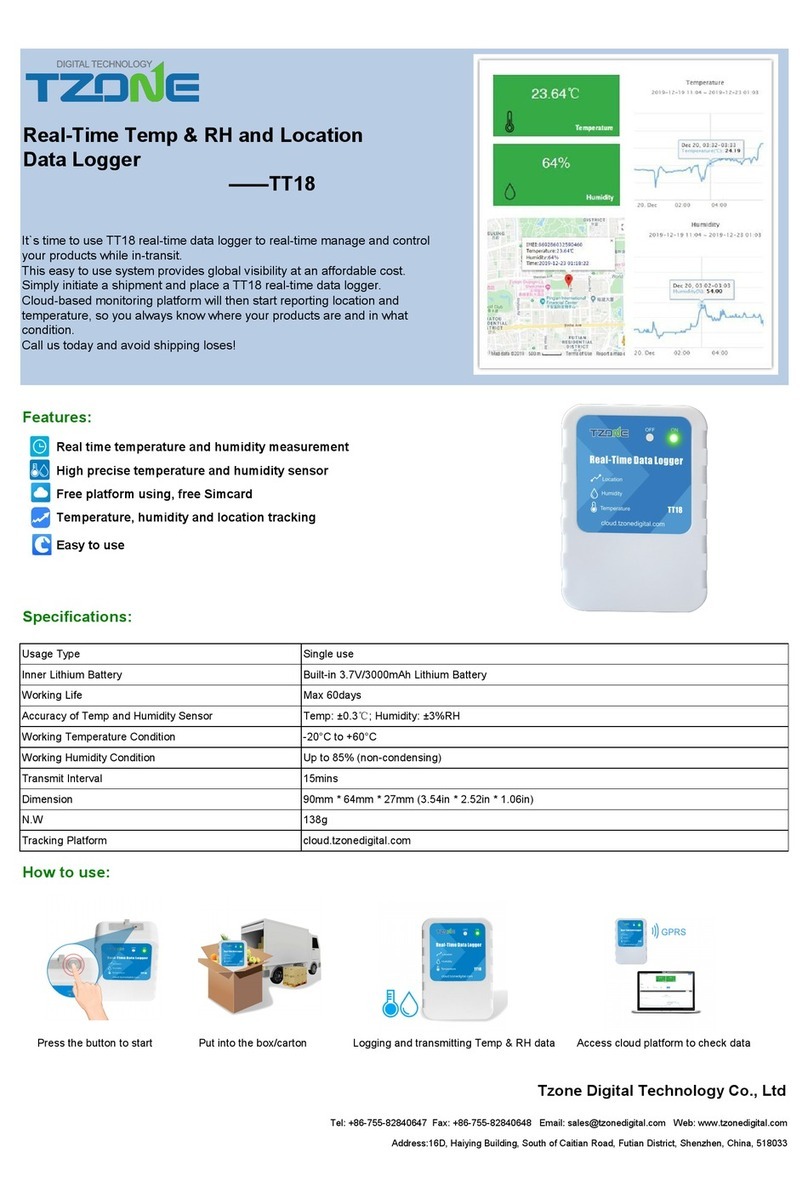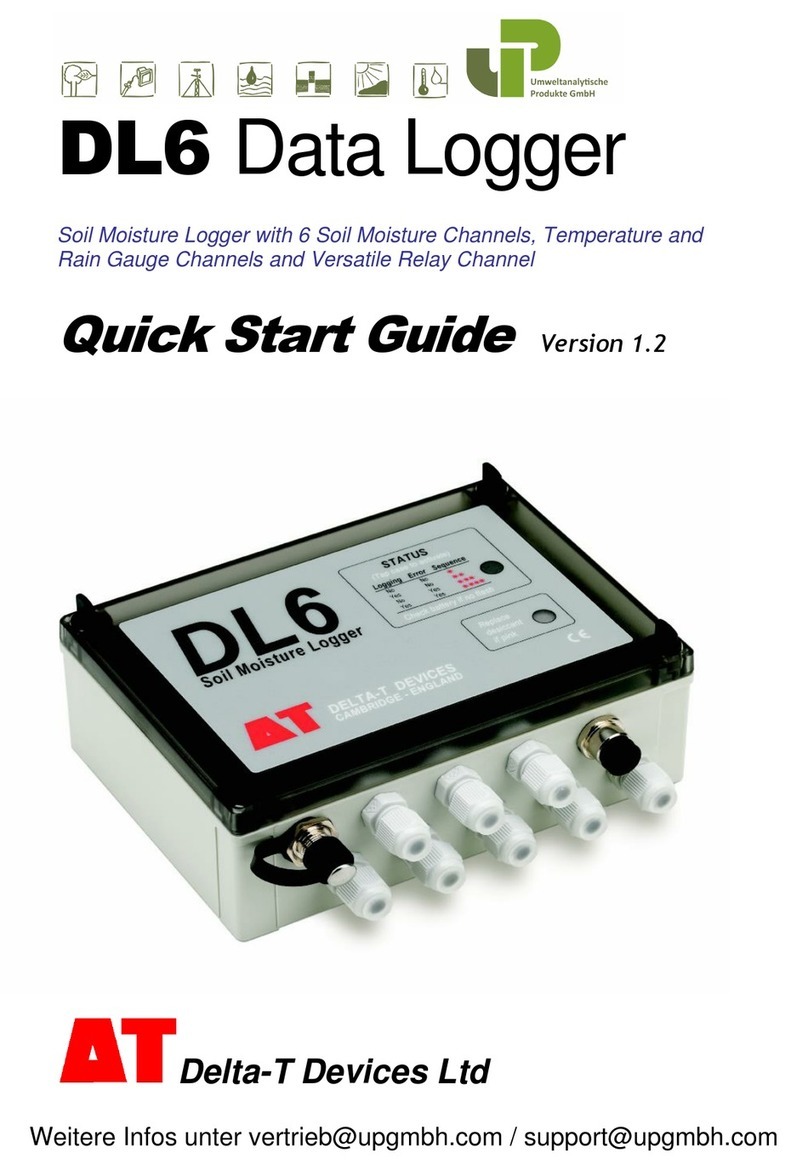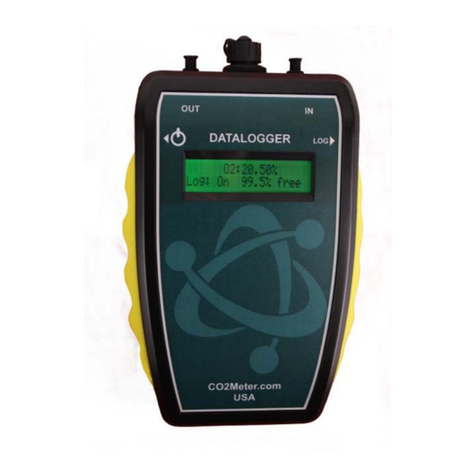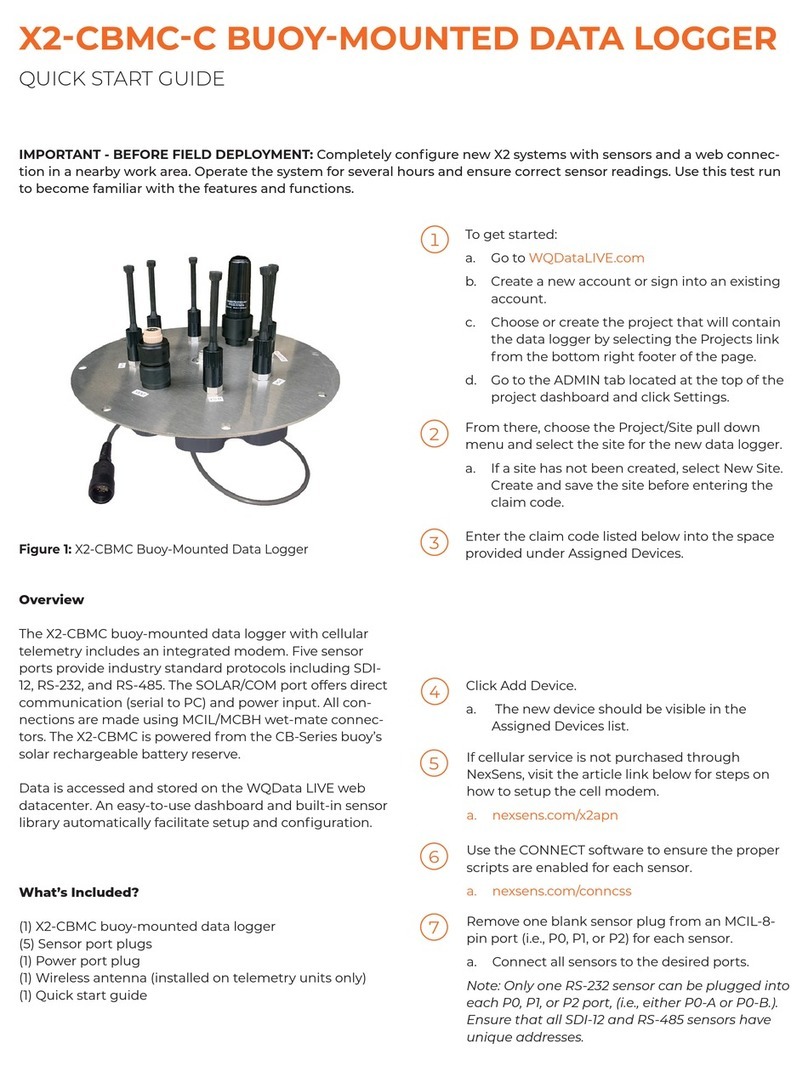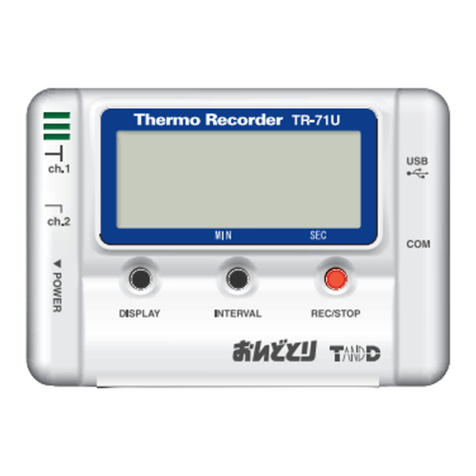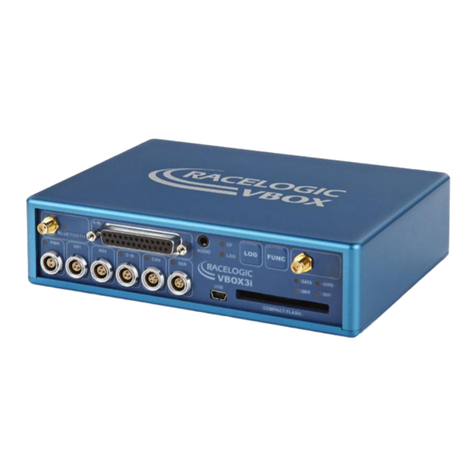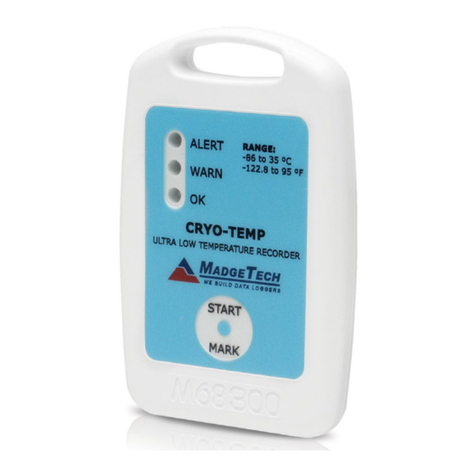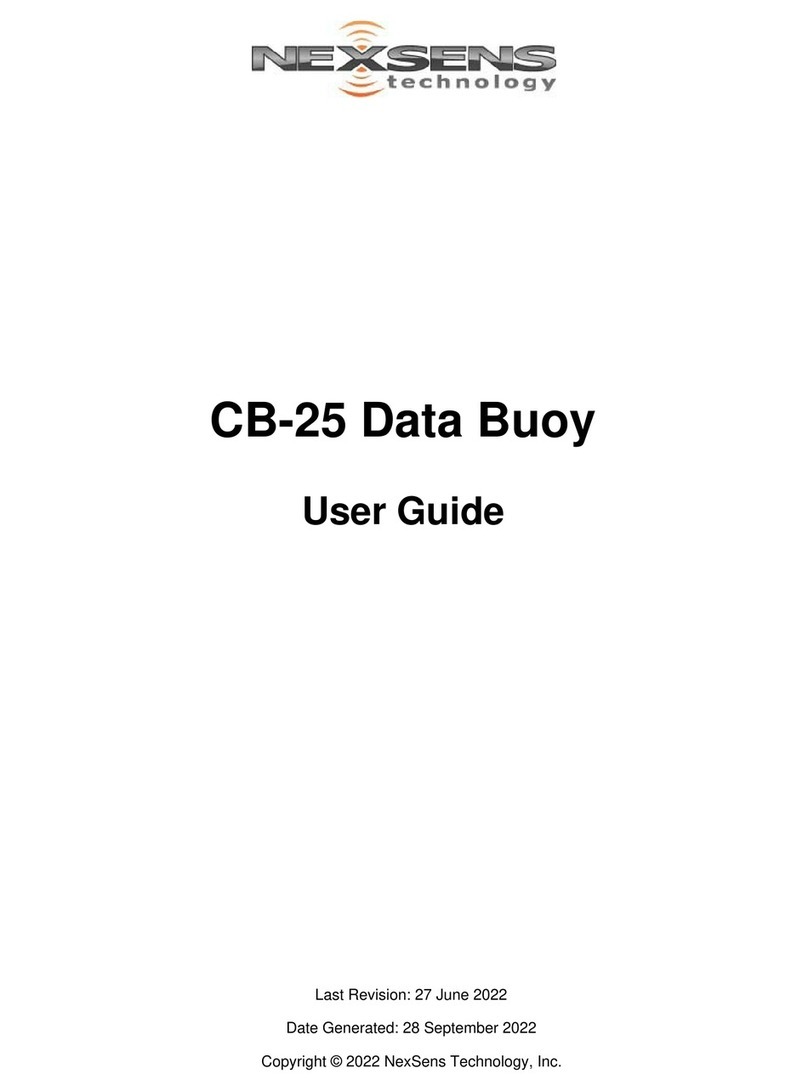Dataq DI-4108 User manual

The way PC-based instrumentation should be
DI-4108 and DI-4208
8-Channel High Speed Data Acquisition Systems with Programmable Gain,
Expandability with ChannelStretch™, and Stand-alone Capability
User's Manual
Manual Revision G
Copyright © 2020 by DATAQ Instruments, Inc. The Information contained herein is the exclusive property of
DATAQ Instruments, Inc., except as otherwise indicated and shall not be reproduced, transmitted, transcribed, stored
in a retrieval system, or translated into any human or computer language, in any form or by any means, electronic,
mechanical, magnetic, optical, chemical, manual, or otherwise without expressed written authorization from the com-
pany. The distribution of this material outside the company may occur only as authorized by the company in writing.
DATAQ Instruments' hardware and software products are not designed to be used in the diagnosis and treatment of
humans, nor are they to be used as critical components in any life-support systems whose failure to perform can rea-
sonably be expected to cause significant injury to humans.
DATAQ, the DATAQ logo, and WINDAQ are registered trademarks of DATAQ Instruments, Inc. All rights reserved.
DATAQ Instruments, Inc.
241 Springside Drive
Akron, Ohio 44333 U.S.A.
Telephone: 330-668-1444
Fax: 330-666-5434
Designed and manufactured in the
United States of America


iii
Warranty and Service Policy
Product Warranty
DATAQ Instruments, Inc. warrants that this hardware will be free from defects in materials and workmanship under
normal use and service for a period of 1 year from the date of shipment. DATAQ Instruments' obligations under this
warranty shall not arise until the defective material is shipped freight prepaid to DATAQ Instruments. The only
responsibility of DATAQ Instruments under this warranty is to repair or replace, at its discretion and on a free of
charge basis, the defective material.
This warranty does not extend to products that have been repaired or altered by persons other than DATAQ Instru-
ments employees, or products that have been subjected to misuse, neglect, improper installation, or accident.
DATAQ Instruments shall have no liability for incidental or consequential damages of any kind arising out of the
sale, installation, or use of its products.
Service Policy
1. All products returned to DATAQ Instruments for service, regardless of warranty status, must be on a freight-pre-
paid basis.
2. DATAQ Instruments will repair or replace any defective product within 5 days of its receipt.
3. For in-warranty repairs, DATAQ Instruments will return repaired items to the buyer freight prepaid. Out of war-
ranty repairs will be returned with freight prepaid and added to the service invoice.


DI-4108 and DI-4208 Hardware Manual
Table of Contents
v
Table of Contents
Warranty and Service Policy ................................................................................................................ iii
1. Introduction ........................................................................................................................................ 1
Features .............................................................................................................................................. 1
Analog Inputs .................................................................................................................................... 1
Digital I/O .......................................................................................................................................... 2
Software ............................................................................................................................................. 2
WinDaq® Recording and Playback Software ............................................................................ 2
Help ............................................................................................................................................. 2
2. Specifications ...................................................................................................................................... 3
3. Installation .......................................................................................................................................... 7
Install WinDaq Software ................................................................................................................... 7
Connect the Instrument to Your Computer ....................................................................................... 8
Install an Ethernet Device on Your Local Area Network ................................................................. 8
4. Controls, Indicators, and Connections ............................................................................................. 9
Mini-B USB Connection ................................................................................................................... 9
Screw Terminals ................................................................................................................................ 9
DI-4108 Signal Connections ....................................................................................................... 10
DI-4208 Signal Connections ....................................................................................................... 10
GnD: Ground. .............................................................................................................................. 11
Connecting Signal Leads ............................................................................................................ 11
Analog Inputs .............................................................................................................................. 11
Low-pass Filter ..................................................................................................................... 13
Resolution as a Function of Sample Rate ............................................................................. 13
Digital Ports ................................................................................................................................ 14
WinDaq Remote Events (D0 Event) .................................................................................... 15
WinDaq Remote Storage (D1 Record) ................................................................................. 17
WinDaq Rate (D2 Rate) ....................................................................................................... 17
WinDaq Counter (D3 Count) ............................................................................................... 19
General Purpose Digital Inputs ............................................................................................ 21
General Purpose Digital Outputs .......................................................................................... 22
4-20mA Current Loop Measurements ............................................................................................... 23
Mode LED Indicator .......................................................................................................................... 24
Control Button Operations ................................................................................................................. 25
Record Data to USB Thumb Drive ............................................................................................. 25
Stop Recording to USB Thumb Drive ........................................................................................ 26
Fix Errors .................................................................................................................................... 26
Switching between LibUSB and CDC Modes ............................................................................ 26
Save Ethernet and Stand-alone configuration to Thumb Drive .................................................. 26
Apply Ethernet and Stand-alone Configuration to Device ......................................................... 27
WinDaq Dashboard ........................................................................................................................... 27
ChannelStretch™ ............................................................................................................................... 28
Connection .................................................................................................................................. 29
Channel Selection ....................................................................................................................... 30
5. Unlock WinDaq or Stand-alone ........................................................................................................ 31
6. Dimensional Drawing ......................................................................................................................... 33


DI-4108 and DI-4208 Hardware Manual
Introduction
1
1. Introduction
This manual contains information designed to familiarize you with the features and functions of the DI-4108 and DI-
4208 USB data acquisition systems.These systems are identical excluding gain ranges.
Features
Both the DI-4108 and DI-4208 data acquisition instruments are portable data recording modules that communicate
through your computer's USB and/or Ethernet port with stand-alone capability. Features include:
• 8 fixed differential analog inputs protected to 120 V rms.*
• USB, Ethernet, and Power over Ethernet (PoE) interface options.
• 7 digital ports protected to +25V.*
• Up to 16-bit measurement resolution (dependent on sample rate).
• The DI-4108 has programmable measurement ranges of ±200, ±500 mV, ±1, ±2, ±5, ±10 Volts.
• The DI-4208 has programmable measurement ranges of ±2, ±5, ±10, ±20, ±50, ±100 Volts.
• Up to 160 kHz maximum throughput sampling rate.
• Adaptable low-pass filter per channel - corner frequency set as a function of sampling rate
• A multi-purpose push-button for WINDAQ remote events and start/stop recording.
• Multi-color LED indication for easy notification of device status.
• Free WinDaq/Lite data acquisition recording software. Records up to four channels of data. Purchase an unlock
code to record more than four channels.
• Stand-alone option allows the user to configure a recording session through their PC then record data in the field
to removable flash memory via the USB drive port (without being connected to their PC). Stand-alone data log-
ging requires Unlock code to record more than 1 channel to removable flash memory.
• Counter channel.
• Frequency channel.
• ChannelStretch™ Technology allows you to sync up to 16 DI-1120, -4108, or -4208 instruments in any combina-
tion with a total throughput of 480kHz or more (requires unlock code for each device).*
• Included .Net Class supports programming under any .Net programming language.*
• Fully documented instrument protocol for programming the device in operating systems other than Windows.*
*WinDaq/Unlock required per device to use ChannelStretch™ and to record more than four total channels when
using WinDaq software. These restrictions do not apply when programming the device yourself.
Analog Inputs
Both the DI-4108 and DI-4208 feature eight differential channel inputs located on a single sixteen-position screw ter-
minal block for easy connection and operation. Gain measurement ranges of ±200, ±500 mV, ±1, ±2, ±5, ±10 Volts
for the DI-4108 or ±2, ±5, ±10, ±20, ±50, ±100 Volts for the DI-4208 are programmable on a per channel basis. Ana-
log channels are protected to 120 V rms.
Utilize the functionality of WINDAQ software to experience all the features encased in these small, inexpensive
instruments. An Unlock Code is required to record more than four channels of any type on either device or to syn-

DI-4108 and DI-4208 Hardware Manual
Introduction
2
chronize multiple units when using WinDaq software. There are no restrictions when programming the instruments
yourself.
Digital I/O
The DI-4208 contains seven digital ports, which may be used as a general-purpose digital input or for a specific func-
tion as designated on the device. Digital port D0 may be used for WinDaq Events; Digital port D1 may be used for
WinDaq remote Start/Stop; Digital port D2 may be used for rate measurements; Digital port D3 may be used for
counts; Digital ports D4 and D5 are general purpose digital input ports. Please Note: Digital outputs are not supported
in WinDaq software. Each port may be configured as a switch using either the provided protocol or .Net class.
Software
All software required to record and playback waveforms is included with the purchase of any DI-4108 or 4208 data
acquisition system via download. Use the WinDaq Dashboard to access WinDaq Acquisition software or to setup the
stand-alone configuration.
WINDAQ®Recording and Playback Software
WINDAQ Acquisition and WINDAQ Waveform Browser allow you to record and playback data acquired through your
instrument. WINDAQ software is an invaluable resource to record and analyze your data and is available for free from
our web site (www.dataq.com).
WINDAQ Lite Data Acquisition software (free) can be used to record waveforms directly and continuously to disk
while monitoring a real time display of the waveforms on-screen. It operates, displays, and records up to four chan-
nels in real time. An optional unlock code is available to record the rest of the channels on the device or to allow you
to sync multiple units.
WINDAQ Waveform Browser playback software (also known as “WWB”) offers an easy way to review and analyze
acquired waveforms. A built-in data file translator allows the user to display multiple waveforms acquired by
WINDAQ Acquisition software or any of a wide range of data acquisition packages. The software’s disk-streaming
design allows data files of any length to be graphically displayed rapidly, in normal or reverse time directions. Seven
standard cursor-based measurements, frequency domain, and statistical analysis functions help simplify waveform
analysis and interpretation. WINDAQ Waveform Browser is free and installed when installing WINDAQ Software.
Help
All WINDAQ software utilizes context-sensitive help. Help may be accessed through the Help menu or by pressing the
F1 key with any pull-down menu item selected. This will take you directly to the Help topic most relevant to that par-
ticular function or feature. Help topics discuss in detail each function available in the software.

DI-4108 and DI-4208 Hardware Manual
Specifications
3
2. Specifications
Analog Inputs
Number of Channels: 8
Channel Configuration: Differential
Measurement range per channel: DI-4108: Programmable ±200, ±500 mV, ±1, ±2, ±5, ±10 V
DI-4208: Programmable ±2, ±5, ±10, ±20, ±50, ±100 V
Input impedance: DI-4108: 100 k differential
DI-4208: 795 k differential
Absolute accuracy: 0.25% of full scale range @ 25°C, excluding common mode error
Absolute maximum input without damage:
120 V rms (normal mode + common mode)
Maximum common mode voltage:
Common mode range: ±20 V dc or peak ac
Common mode rejection ratio: 50 dB (dc - 60 Hz)
Channel-to-channel crosstalk rejection: -80 dB
ADC Characteristics
Resolution: 12- to 16-bit
Above zero ADC counts: 2,047 to 32,767
Below zero ADC counts: 2,048 to 32,768
Max. throughput sample rate: Standard: 160 kHz
Stand-alone: 20 kHz to 160 kHz (dependent on flash memory)
Min. throughput sample rate: Standard: 20 Hz (2.2 samples per hour with WinDaq)
Stand-alone: 0.0017 Hz
Sample rate timing accuracy: 50 ppm
Digital Ports
Number of Ports: 7
Type: MOSFET switch
Configuration: Programmable as digital input or switch
Threshold levels TTL compatible
Absolute maximum applied voltage (V): 25 V dc
Reserved Digital Inputs
Port 1: WINDAQ remote events
Port 2: WINDAQ remote start/stop
Port 3: Rate input
Port 4: Count input
Count/Rate/Digital Inputs
Internal pull-up value: 4.7 k
Input high voltage threshold: 2.4 V

DI-4108 and DI-4208 Hardware Manual
Specifications
4
Input low voltage threshold: 0.8 V
Terminal count: 65,535
Maximum rate frequency: 50 KHz with one enabled channel
20 KHz with 2-4 enabled channels
10 KHz with 5-7 enabled channels
Minimum rate frequency: 0.5 Hz
Maximum count frequency: 50 kHz
Digital Ports Programmed as Switch
Maximum drain voltage: 25V
Maximum sink current: 100 mA
Ethernet Interface
Type: 10/100Base-T
Connector: RJ-45
Protocol: TCP/IP
Server Type: DHCP or Fixed IP
Removable Memory
Type: MLC, pSLC, or SLC flash memory (with USB SD card reader); USB
thumb drive
Required Format: FAT32
Number of Channels: 1; Unlock code required for 2 or more
Indicators and Connections
USB Interface: USB 2.0 (mini-B style connector)
Button: Multi-function control (Start, Stop, Save Configuration, Apply Configu-
ration)
USB A Connector (Drive): USB drive for Stand-alone data logging
Cannot be used concurrently with the USB interface
Input connections: Two 16-position screw terminal strips
Status LED: One multicolor LED for status indication
USB ChannelStretch™ Operation
Total Max Units: 16
Max Channel Count: 128 Analog, 112 Digital
Max Throughput: ≥480 kHz (higher speeds may result in data loss)
Channel skew between any 2 units: 10 µS, typical
Synchronization Conditions: Syncs with any combination of DI-1120, DI-4108, DI-4208, and DI-
4718B USB instruments.
All synced instruments must operate at the same sample rate per channel,
regardless of channel number, type, or range.
All instruments must be connected to the same USB controller. The use
of USB hubs are recommended to meet this requirement.

DI-4108 and DI-4208 Hardware Manual
Specifications
5
Ethernet ChannelStretch™ Operation
Total Max Units: 16
Max Channel Count: 128 Analog, 112 Digital
Max Throughput: ≥50 kHz (higher speeds may result in data loss)
Channel skew between any 2 units: 10 µS, typical
Synchronization Conditions: Syncs with any combination of DI-1120, DI-4108, DI-4208, and DI-
4718B Ethernet instruments.
For most accurate synchronization, all instruments should be connected
to the same Ethernet switch.
Power
Power Consumption: <1.0 Watt, via USB interface
Environmental
Operating Temperature: 0°C to 50°C (32°F to 122°F)
Operating Humidity: 0 to 90% non-condensing
Storage Temperature: -20°C to 60°C (-4°F to 140°F)
Storage Humidity: 0 to 90% non-condensing
Physical Characteristics
Enclosure: Hardened plastic
Mounting: Desktop; bulkhead
Dimensions: 6.68D × 3.28W × 1.13H in.
(169.67D × 83.31W × 28.7H cm.)
Weight: 5.7 oz. (162 grams)
Software Support
WINDAQ software: OS support: Check online at http://www.dataq.com/products/windaq/
windows-compatability/
Programming: Instrument Protocol, .NET class


DI-4108 and DI-4208 Hardware Manual
Installation
7
3. Installation
The following items are included with each DI-4108 or DI-4208 USB Data Acquisition System. Verify that you have
the following:
• A DI-4108 or DI-4208 USB data acquisition instrument.
• 6-foot USB cable; Ethernet versions also provide a 5-foot Ethernet cable and an AC power supply if required
(PoE versions do not come with a power supply).
• A DATAQ Instruments screwdriver for signal lead connections.
• A USB flash drive with WinDaq software. Can also be used for stand-alone data logging.
If an item is missing or damaged, call DATAQ Instruments at 330-668-1444. We will guide you through the appropri-
ate steps for replacing missing or damaged items. Save the original packing material in the unlikely event that your
unit must, for any reason, be sent back to DATAQ Instruments.
Install WINDAQ Software
All software for the DI-4108 and DI4208 can be installed via a download-able executable directly from the DATAQ
Instruments web site. The software is also available on the provided USB flash drive.
1. Disconnect all DATAQ Instruments USB devices from your Computer.
2. Plug the USB flash drive into your computer’s USB port or go to http://run.dataq.com to download the software.
3. Save the executable (Dataq Software Suite Web Setup.exe) to your local hard drive.
4. Double-click on the executable to extract the program and begin software installation.
5. Follow the on-screen prompts and enter all required information.

DI-4108 and DI-4208 Hardware Manual
Installation
8
6. Software installation is complete - you will now see a “Successful Installation” box - click OK to exit WINDAQ
Installation.
You can now plug the device(s) into your PC. Click on the appropriate program group (specified above — default is
Start > Programs > WINDAQ) and click on “WinDaq Dashboard” to access WINDAQ software.
Connect the Instrument to Your Computer
All DI-4108 and DI-4208 instruments can be connected to your computer’s USB port using the provided USB cable.
No external power is required when connected via the USB port. Connect one end of the communications cable to the
instrument port and the other to your PC’s port. Ethernet devices are equipped with a USB port and can be used as a
USB device. Open the WinDaq Dashboard to run WinDaq Data Acquisition software, set the device clock, and con-
figure and record data to a thumb drive.
Note: Use a powered USB hub or a USB port on your PC. Non-powered USB hubs may not have sufficient power to
run the instrument.
Install an Ethernet Device on Your Local Area Network
All Ethernet instruments are shipped DHCP-enabled. We recommend you setup a DHCP reservation on your network
for your data acquisition applications.
1. Find the MAC address of your DI-4x08. The device MAC address is printed on the bottom label of the device:
2. Login to your Router and ensure the DHCP server is enabled.
3. Access the DHCP Reservations, Static DHCP, or IP Allocations page/table.
4. Enter the MAC address of your device in the table (you may need to enter colons for proper format - for example,
001B1000232 may need to be 00:1B:81:00:02:32), enter an unused IP address in the table row (or allow your
router to select it for you if possible), and Select/Enable for DHCP Reservation.
5. Save your router settings.
6. Connect your DI-4x08 unit into your Local Area Network using the supplied Ethernet Cable.
7. Apply Power to the device if required. PoE devices can derive power from a PoE switch.
Open the WinDaq Dashboard utility to access device settings and run WinDaq Data Acquisition software. The
WinDaq Dashboard allows you to set the device clock, change your Ethernet settings (DHCP/Static), setup and
record to a thumb drive, access files on the thumb drive, and view live data.
If your device is not discovered in WinDaq Dashboard, connect it to your computer via the USB cable and configure
the Ethernet settings to allow for DHCP.
If the device is available in WinDaq Dashboard but you cannot run WinDaq Acquisition software, you may have the
application blocked in Windows Firewall. See https://www.dataq.com/blog/data-acquisition-software/is-the-win-
dows-defender-firewall-blocking-windaq/ for more information and resolution.

DI-4108 and DI-4208 Hardware Manual
Controls, Indicators, and Connections
9
4. Controls, Indicators, and
Connections
Mini-B USB Connection
Use the supplied USB cable to connect and power the instrument through your computer’s USB port.
Screw Terminals
All input signal connections are made to the 16-port screw terminals. Each terminal is labeled on the instrument case.
CAUTION
Never touch exposed screw terminal connector pins or screws.
To avoid ESD damage in handling the device, take the following precautions:
Ground yourself with a grounding strap or by touching a grounded object before and during your handling of the
instrument.
Analog In Channels 1-8
Digital Ports 0-6
Even Marker
Push Button
Activity LED
+5V Out Ground
Mini-B USB
Connection
Bulkhead
mounting ear
Bulkhead
mounting ear
USB Drive
Ethernet Connection
(optional)
Status
D0 D1 D2 D3 D4 D5 D6
Model DI-4108 or DI-4208
USB
Button
+5V GnD
CH8
CH7CH6
CH5CH4CH3CH2CH1
120 V rms
0-25V Max
CountRateRecordEvent
Drive
www.dataq.com
±2 to ±100 V F.S.
Ethernet
!
!

DI-4108 and DI-4208 Hardware Manual
Controls, Indicators, and Connections
10
DI-4108 Signal Connections
Refer to the following for screw terminal port identification.
Ch#: Analog channels 1-8 (Programmable ±200, ±500 mV, ±1, ±2, ±5, ±10 Volts, 120 V rms max.)
D#: Digital port (0-6). Can also be used for specific WINDAQ functions (+25 Vmax).
D0 Event — WINDAQ Remote Event Marker (or general-purpose)
D1 Record — WINDAQ Remote Start/Stop (or general-purpose)
D2 Rate — Rate Input (or general-purpose)
D3 Count — Counter Input (or general-purpose)
D4 and D5 — General-purpose digital ports
D6 Ext Trig — External Trigger (or general-purpose)
+5V: +5V out. Max current = 100mA.
GnD: Ground.
DI-4208 Signal Connections
Refer to the following for screw terminal port identification.
Ch#: Analog channels 1-8 (Programmable ±2, ±5, ±10, ±20, ±50, ±100 Volts, 120 V rms max.)
D#: Digital port (0-6). Can also be used for specific WINDAQ functions (+25 Vmax).
D0 Event — WINDAQ Remote Event Marker (or general-purpose)
D1 Record — WINDAQ Remote Start/Stop (or general-purpose)
D2 Rate — Rate Input (or general-purpose)
D3 Count — Counter Input (or general-purpose)
D4 and D5 — General-purpose digital ports
D6 Ext Trig — External Trigger (or general-purpose)
Status
D0 D1 D2 D3 D4 D5 D6
Model DI-4108
USB
Button
+5V GnD
CH8
CH7CH6
CH5CH4CH3CH2CH1
120 V rms
0-25V Max
CountRateRecordEvent
Drive
www.dataq.com
±200mV to ±10 V F.S.
Ethernet
Status
D0 D1 D2 D3 D4 D5 D6
Model DI-4208
USB
Button
+5V GnD
CH8
CH7CH6
CH5CH4CH3CH2CH1
120 V rms
0-25V Max
CountRateRecordEvent
Drive
www.dataq.com
±2 to ±100 V F.S.
Ethernet

DI-4108 and DI-4208 Hardware Manual
Controls, Indicators, and Connections
11
+5V: +5V out. Max current = 100mA.
GnD: Ground.
Connecting Signal Leads
Connect signal leads to the DI-4108 or DI-4208:
1. Insert the stripped end of a signal lead into the desired terminal directly under the screw.
2. Tighten the pressure flap by rotating the screw clockwise with a small screwdriver. Make sure that the pressure
flap tightens only against the signal wire and not the wire insulation. Do not over-tighten.
3. Tug gently on the signal lead to ensure that it is firmly secured.
When an input signal is connected and WINDAQ Acquisition software is run, WINDAQ’s real time display immedi-
ately reveals the input waveform on your computer’s monitor.
Analog Inputs
Eight differential analog inputs measure ±200, ±500 mV, ±1, ±2, ±5, ±10 Volts on the DI-4108or ±2, ±5, ±10, ±20,
±50, ±100 Volts for the DI-4208 (CH1 to CH8, programmable per channel) . Designed to withstand 120 Vrms.
798K
AIN
798K
10K
10K
AIN
VB
10K
VB
10K 4.7K
VB
1500 pF
PGA

DI-4108 and DI-4208 Hardware Manual
Controls, Indicators, and Connections
12
Use the following diagram to connect Analog Input Channel 1.
Specify a full scale range for the channel in the menu item Edit > Channel Settings.
Scroll through all enabled channels with the Next and Previous buttons.
DI-4108 Channel Settings DI-4208 Channel Settings
Status
D0 D1 D2 D3 D4 D5 D6
Model DI-4108 or DI-4208
USB
Button
+5V GnD
CH8
CH7CH6
CH5CH4CH3CH2CH1
120 V rms
0-25V Max
CountRateRecordEvent
Drive
www.dataq.com
±2 to ±100 V F.S.
Ethernet
Signal + Signal -

DI-4108 and DI-4208 Hardware Manual
Controls, Indicators, and Connections
13
Low-pass Filter
Each analog channel employs a low-pass filter with automatic corner frequency selection. The filter is a CIC (cas-
caded integrator comb) type that uses as many as 512 samples per channel to calculate in real time as data is acquired.
Filter response is optimized when sampling frequency is set to ten times the highest frequency of interest.
The DI-4108 and DI-4208 calculate its own Last Point, Maximum, Minimum, and Filter data making it available at
the programming level. Acquisition methods “RMS” and “Frequency” are permanently disabled for the DI-4108 and
DI-4208, as are Input Types “Nonlinear” and “Thermocouple” and selections for “Unipolar” and “Fahrenheit.”
Resolution as a Function of Sample Rate
The resolution of the DI-4108 and DI-4208 is a function of sample rate. The lower the sample rate the higher the res-
olution. ADC resolution (R) is a function of selected sample rate per channel (F), and the number of enabled analog
channels (C):
C Enabled Channels
11
22
43-4
85-8

DI-4108 and DI-4208 Hardware Manual
Controls, Indicators, and Connections
14
Digital Ports
The DI-4108 and DI-4208 contain 7 general-purpose digital ports. Each digital port can be configured as a digital input
or used as a switch to control an external load (up to 25 V and 100 mA). Many of the ports also provide specific func-
tionality in WINDAQ or a third-party program.
D0 Event is for WINDAQ Remote Events. This bit inserts an event marker in your data.
D1 Record is for WINDAQ Remote Storage. This bit can be programmed to begin recording data.
D2 Rate is for Rate measurements: 10Hz to 50kHz.
D3 Count is for Counter/Timer measurements up to 65,536.
D4 and D5 are general-purpose digital inputs.
D6 Ext Trig is for third-party external triggers.
This manual suits for next models
1
Table of contents
Other Dataq Data Logger manuals

